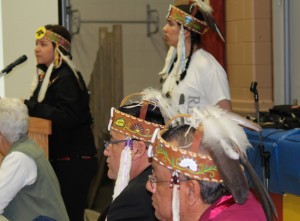Anishinabek education needs ‘two sneakers’

By Marci Becking
NIPISSING FN – Anishinabek Nation interim youth rep Quinn Meawasige likens an Anishinabek Education System to having one foot in a moccasin and one in a sneaker.
“We still need the tools from Western education, but at the same time, we need what our culture can teach us,” says Meawasige, 20 from Serpent River First Nation. “After seeing what Nbisiing has to offer – I want to go back to high school now!”
Meawasige, along with co-youth representative Nathalie Restoule from Dokis First Nation, spoke to some 175 participants at the Anishinababe Kinomaadswin Nongo Anishinaabe Pane – Education Summit at Nbisiing Secondary School in Nipissing First Nation. The symposium attracted representatives from 33 of the 39 Anishinabek First Nations.
“It’s our right to educate our children,” says Meawasige. “Our teachings come from the Elders…the belts. We learn about geography from the bush.”
Restoule spoke about the AFN National youth summit that she and Meawasige attended in November where INAC Minister Bernard Valcourt tried to get endorsement of the First Nations Education Act from First Nations youth.
“The youth told him that this is not our system – we do not accept or endorse,” said Restoule. “The youth at the summit all had the same vision and goal. Also at last summer’s youth forum we realized that we’re all in this together. Nothing can stop us and it’s the pride we hold.”
Restoule said that the youth need language and culture.
“We really fight for the clean water and good land but we need to nurture the Anishinabek spirit. It all goes back to identity – the language and the culture,”
Meawasige added, “I think that’s why Valcourt added the ‘First Nations Control’ bit to the FNEA – there would have been a strong fight from the youth in this country. I don’t see why we need the FNCFNEA when we have our system right here.”
Grand Council Chief Patrick Madahbee says the Anishinabek Education System is ready to go.
“Our frontline education specialists from our communities have come together to develop a model that looks at the administrative, financial, curriculum aspects. We need to deliver education services outside of the mainstream process which so far hasn’t been successful for our communities.”
Education negotiator Tracey O’Donnell says that in the negotiations with Canada – which are entering their 19th year –Anishinabek are not seeking Canada’s jurisdiction or authority.
“We’re looking for Canada’s recognition of jurisdiction that we already have,” says O’Donnell. “Who can better educate the Anishinabek, than Anishinabek themselves? This system was designed by the Anishinabek, for the Anishinabek.”
She says that the Anishinabek Education Act is in draft right now.
“The way the act is drafted it allows each of the First Nations to determine what aspects of the law that will apply in their own community. That law will be approved by the leadership and citizens of each individual First Nation. That will allow the community to exercise jurisdiction over education on terms that match their community needs. With those laws in place, we won’t only have programs and service enhancement, but a new relationship with the provincial government.
“For those communities that have tuition agreements in place, we’re not going to replace those or disturb the good arrangements that exist – just enhance the education relationship between the First Nations and the local school boards through the Ministry of Education. The good things that are there, we’ll build on those and what we’ll do is increase education opportunities for students and Anishinabek success.”
Next steps for the ratification process of the Anishinabek Education Agreement, the Education Fiscal Transfer Agreement and the Framework for the Master Education Agreement with Ontario will all be discussed at the Grand Council Assembly June 3-5, 2014 in Long Lake #58 First Nation.

